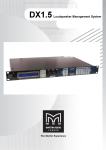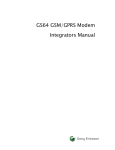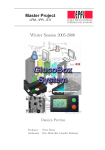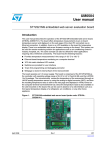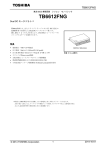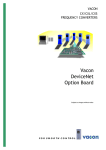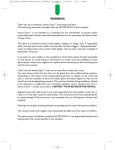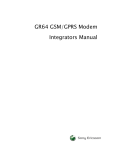Download Wavecom GX64 Specifications
Transcript
Gx64 APPLICATION NOTE Power Management Reference: WI_DEV_Gx64_APN_007 Version: 001 Date: 2007/01/31 Trademarks ®, WAVECOM®, WISMO®, Open AT®, Wireless CPU®, Wireless Microprocessor® and certain other trademarks and logos appearing on this document, are filed or registered trademarks of Wavecom S.A. in France or in other countries. All other company and/or product names mentioned may be filed or registered trademarks of their respective owners. Copyright This manual is copyrighted by WAVECOM with all rights reserved. No part of this manual may be reproduced in any form without the prior written permission of WAVECOM. No patent liability is assumed with respect to the use of the information contained herein. No Warranty WAVECOM publishes this manual without making any warranty as to the content contained herein. Further Wavecom Inc reserves the right to make modifications, additions and deletions to this manual due to typographical errors, inaccurate information, or improvements to programs and/or equipment at any time and without notice. Such changes will, nevertheless be incorporated into new editions of this manual. Gx64 APPLICATION NOTE Power Management Page: 2/30 This document is the sole and exclusive property of WAVECOM. Not to be distributed or divulged without prior written agreement. Ce document est la propriété exclusive de WAVECOM. Il ne peut être communiqué ou divulgué à des tiers sans son autorisation préalable Table of Contents 1 Introduction ............................................................................................ 5 1.1 ABBREVIATIONS ............................................................................................................ 5 1.2 NOTATION.................................................................................................................... 6 1.3 ACKNOWLEDGEMENTS .................................................................................................. 6 2 Block Diagrams ....................................................................................... 7 2.1 SYSTEM POWER MANAGEMENT BLOCK DIAGRAM ........................................................... 7 2.2 POWER MANAGEMENT BLOCK DIAGRAM ........................................................................ 8 2.2.1 GS64.................................................................................................................. 8 2.2.3 GR64002 ......................................................................................................... 10 2.2.2 3 GR64001 ........................................................................................................... 9 Implementation Recommendations ....................................................... 11 3.1 APPLYING POWER ON VCC........................................................................................... 11 3.2 POWER STATE CONTROL OF THE WIRELESS CPU........................................................... 12 3.2.1 ON/OFF ........................................................................................................... 13 3.2.3 EXTERNAL PON_H............................................................................................. 14 3.2.2 INTERNAL CHGDET........................................................................................... 14 3.2.4 ALARM............................................................................................................. 15 3.2.6 AT*E2RESET ..................................................................................................... 16 3.2.5 AT+CFUN ........................................................................................................ 16 3.3 HOW TO LOWER POWER CONSUMPTION ...................................................................... 16 3.4 CHARGING.................................................................................................................. 17 3.5 HOW TO USE VREF ...................................................................................................... 17 3.5.1 3.5.2 VREF AS OUTPUT IN GS64 AND GR64001 ......................................................... 17 VREF AS INPUT IN GR64002.............................................................................. 18 3.6 MONITOR “POWER ON” STATE ..................................................................................... 19 3.6.1 GS64 AND GR64001 HW-DETECTION ............................................................... 19 3.6.2 GR64002 HW-DETECTION ................................................................................ 20 Gx64 APPLICATION NOTE Power Management Page: 3/30 This document is the sole and exclusive property of WAVECOM. Not to be distributed or divulged without prior written agreement. Ce document est la propriété exclusive de WAVECOM. Il ne peut être communiqué ou divulgué à des tiers sans son autorisation préalable 3.7 VRTC AND ALARM ...................................................................................................... 22 3.7.1 4 USING ALARM AS PERIODIC POWER ON ............................................................. 22 Reference Designs ................................................................................ 24 4.1 DISCLAIMER ................................................................................................................ 24 4.2 DC/DC POWER SUPPLY ................................................................................................ 24 4.2.1 BILL OF MATERIAL ............................................................................................ 24 4.3 AC/DC POWER SUPPLY ................................................................................................ 25 4.3.1 SPECIFICATIONS ............................................................................................... 25 4.3.3 BILL OF MATERIAL ............................................................................................ 27 4.3.2 DESIGN SUMMARY............................................................................................ 25 Appendix A ................................................................................................. 28 Appendix B ................................................................................................. 29 Table of Figures Figure 1: System Block Diagram ........................................................................................... 7 Figure 2: GS64 Power Management Block Diagram ............................................................... 9 Figure 3: GR64001 Power Management Block Diagram ......................................................... 9 Figure 4: GR64002 Power Management Block Diagram ....................................................... 10 Figure 5: GR/GS64 HW On/Off Sequence Logic................................................................... 12 Figure 6: Power Management State Diagram....................................................................... 13 Figure 7: Interface circuit implementation for GS64............................................................ 18 Figure 8: Typical VREF level translation implementation in a GR64002 ............................... 19 Figure 9: GR64002 Power State detection........................................................................... 20 Figure 10: ALARM application example .............................................................................. 22 Gx64 APPLICATION NOTE Power Management Page: 4/30 This document is the sole and exclusive property of WAVECOM. Not to be distributed or divulged without prior written agreement. Ce document est la propriété exclusive de WAVECOM. Il ne peut être communiqué ou divulgué à des tiers sans son autorisation préalable 1 Introduction This document describes how to apply power, control power states (On/Off), and give other hints on how to optimise the Wireless CPU implementation. 1.1 Abbreviations Abbreviation CSD CPS DRX Description Circuit Switched Data Charging Power Supply. Indicates the voltage and current limited supply connected to CHG_IN when battery charging is used. Discontinuous Receive. This indicates how often the Wireless CPU has to wake up and look for a page. The mode can be between 2 and 9 and is determined by the base station. FAE Field Application Engineer PSC Power Supply and Indicator PSI Power State Change signal RTC Real-Time-Clock residing in the Wireless CPU. TP UVLD Gx64 APPLICATION NOTE Power Management Page: 5/30 Temperature Protection. Built-in temperature protection of the Power Management ASIC. Under Voltage Level Detect. Voltage level detection of VCC. This document is the sole and exclusive property of WAVECOM. Not to be distributed or divulged without prior written agreement. Ce document est la propriété exclusive de WAVECOM. Il ne peut être communiqué ou divulgué à des tiers sans son autorisation préalable 1.2 Notation The following symbols and admonition notation are used to draw the reader’s attention to notable or crucially-important information. Note Draws the readers attention to pertinent, useful or interesting information NOTE Tip Provides advice, suggestions, guidance or recommendations which augment the formal text TIP Caution Cautionary information must be heeded, it draws the readers attention to the need for understanding, care or watchfulness in relation to the CAUTION ! WARNING information provided Warning Notes marked warning must be heeded, they alert readers to precautionary measures, risks, hazards or safety information which directly effects equipment function, warranty or personnel safety Danger This information must be heeded, it identifies information and cautionary behaviour that otherwise ignored could result in DANGER 1.3 catastrophic equipment failure, bodily injury or death Acknowledgements Parts of this document, including text passages, tables, and illustrations, are reproduced from copyright information by kind permission of Agere Systems Inc. Gx64 APPLICATION NOTE Power Management Page: 6/30 This document is the sole and exclusive property of WAVECOM. Not to be distributed or divulged without prior written agreement. Ce document est la propriété exclusive de WAVECOM. Il ne peut être communiqué ou divulgué à des tiers sans son autorisation préalable 2 Block Diagrams 2.1 System Power Management Block Diagram The GR/GS64 Wireless CPUs have a number of signals in the system connector that affect the power state. The signals in Figure 1 show the signals for all types and variants of the GR/GS64 family of Wireless CPUs. Table 1 below lists what features are available for the different types and variants. Figure 1: System Block Diagram VREF is implemented differently in the two different GR64 variants. VREF is either an input or an output and are obviously mutually exclusive. Figure 1 only shows VREF as an output, which is the way it is implemented in the GR64001 and GS64. The signal can be divided into two types: • Power Supplies and indicators (PSI) • Power state change signals (PSC) The CHG_IN signal is both a PSI and a PSC. Gx64 APPLICATION NOTE Power Management Page: 7/30 This document is the sole and exclusive property of WAVECOM. Not to be distributed or divulged without prior written agreement. Ce document est la propriété exclusive de WAVECOM. Il ne peut être communiqué ou divulgué à des tiers sans son autorisation préalable Table 1: Type / Variant Configuration GR64002 GS64 Type VCC PSI √ 1,3,5,7,9 √ 1,3,5,7,9 √ 2,4,6,8,10,12 CHG_IN PSI/PSC √ 11 √ 11 √ 13 VUSB PSI √ 49 √ 34 VREF as input VREF as output 2.2 GR64001 Feature PSI VRTC PSI ALARM PSC PON_H PSC ON/OFF PSC Pin(s) √ √ √ 34 25 14 Pin(s) √ 34 Pin(s) √ 65 √ 25 √ 31 √ 50 √ 32 √ 21 √ 33 √ 14 Power Management Block Diagram This section describes the individual implementations in the three different designs; GS64, GR64001, and GR64002. Detailed information on the PSC-implementation can be found in 3.2 below 2.2.1 GS64 The GS64 implementation uses all PSC-options listed in Table 1. If a signal is not used it should be left floating. The “PM ON/OFF Sequence Logic” block diagram can be found in Figure 5. Gx64 APPLICATION NOTE Power Management Page: 8/30 This document is the sole and exclusive property of WAVECOM. Not to be distributed or divulged without prior written agreement. Ce document est la propriété exclusive de WAVECOM. Il ne peut être communiqué ou divulgué à des tiers sans son autorisation préalable Figure 2: GS64 Power Management Block Diagram 2.2.2 GR64001 This variant of GR64 only implements two PSC-options, ON/OFF and CHG_IN. Figure 3: GR64001 Power Management Block Diagram The “PM ON/OFF Sequence Logic” block diagram can be found in Figure 5. Gx64 APPLICATION NOTE Power Management Page: 9/30 This document is the sole and exclusive property of WAVECOM. Not to be distributed or divulged without prior written agreement. Ce document est la propriété exclusive de WAVECOM. Il ne peut être communiqué ou divulgué à des tiers sans son autorisation préalable 2.2.3 GR64002 This variant of GR64 implements all four PSC-options, ON/OFF, PON_H, ALARM and CHG_IN. Figure 4: GR64002 Power Management Block Diagram The “PM ON/OFF Sequence Logic” block diagram can be found in Figure 5. Gx64 APPLICATION NOTE Power Management Page: 10/30 This document is the sole and exclusive property of WAVECOM. Not to be distributed or divulged without prior written agreement. Ce document est la propriété exclusive de WAVECOM. Il ne peut être communiqué ou divulgué à des tiers sans son autorisation préalable 3 Implementation Recommendations This section describes how to implement features related to the Power Management of the Wireless CPUs. 3.1 Applying power on VCC Main power is applied to VCC using GND as reference. The source can be any of the following listed types: • Li-Ion battery (3.7V nominal) • AC/DC power supply (3.6V nominal) • DC/DC power supply (3.6V nominal) Reference designs for AC/DC and DC/DC supplies can be found in Appendix A and B at the end of this document. Parameter VCC Condition Supply voltage level Limits Avg. Max. 3.2 3.6 4.5 V 2100 1 mA 2100 2 mA 350 mA 560 mA 35 mA 3.5 mA Voice/CSD call (1up, 1down) IPEAK at max power (32dBm), 4.7ms duration GSM850, GPRS, Class 10 (2up, 3down) at max power (32dBm), 9.4ms duration Voice/CSD call (1 up, 1 down) at max power (32dBm), 4.7ms duration IRMS Unit Min. GSM850, GPRS, Class 10 (2 up, 3 down) at max power (32dBm), 9.4ms duration Standby (locked on channel) 15 Sleep mode 1.4 25 1,2 This is the average maximum current during the transmit pulse. The absolute maximum current can be up to 2500mA, but is only available for a couple of microseconds. Gx64 APPLICATION NOTE Power Management Page: 11/30 This document is the sole and exclusive property of WAVECOM. Not to be distributed or divulged without prior written agreement. Ce document est la propriété exclusive de WAVECOM. Il ne peut être communiqué ou divulgué à des tiers sans son autorisation préalable 3.2 Power state control of the Wireless CPU There are a maximum of six signals that affects the HW power state of the GR/GS64 family of Wireless CPUs; four HW and two SW: • ON/OFF (HW, all Wireless CPUs) • CHG_IN (HW, all Wireless CPUs) • PON_H (HW, GS64 only) • ALARM (HW, GS64 and GR64002 as external, all as internal) • AT+CFUN (SW, all Wireless CPUs) • AT*E2RESET (SW, all Wireless CPUs) Under normal operating conditions, the die temperature should not exceed 125°C. In the event of an external fault or as a result of device misuse, the die temperature could exceed this value by a large margin. CAUTION Should the die temperature exceed 155°C while the unit is powered up, the thermal protection circuit will shut-down all functions and remain disabled until the temperature drops below 130°C, at which point the device can be restarted. This feature is listed as TP (Thermal Protection) througout this document. To power up the hardware VCC must be within 3.2V to 4.5V, and the Power Management ASIC die temperature must be below 130°C. Figure 5: GR/GS64 HW On/Off Sequence Logic Gx64 APPLICATION NOTE Power Management Page: 12/30 This document is the sole and exclusive property of WAVECOM. Not to be distributed or divulged without prior written agreement. Ce document est la propriété exclusive de WAVECOM. Il ne peut être communiqué ou divulgué à des tiers sans son autorisation préalable The two SW power state control signals are not included in Figure 5. This figure only shows the HW-signals. Figure 6: Power Management State Diagram Figure 6 shows the impact five of the six control signals, listed above, have on the Power Management status of the Wireless CPU. The AT*E2RESET is described individually in 3.2.6 below. If a PSC-signal is held active (PON_H high, ON/OFF low, etc.) while the Wireless CPU is active, it is not possible for another PSC-signal to generate a power down request. Any such request will be denied. If a valid power down request is generated while a CPS is available, the Wireless CPU will be set to “Charge Only”-mode. 3.2.1 ON/OFF This system connector signal provides a power up feature similar to a normal cell phone on/off button, i.e. a low pulse will toggle between On-state and Off-state. This signal is weekly pulled up to VCC in the Power Management ASIC by a constant current source. Table 2: ON/OFF signal characteristics Parameter IIL IIH Description Input current VIL Low level detection limit VIH High level detection limit tLow Required time for detection Gx64 APPLICATION NOTE Power Management Page: 13/30 Input Characteristics Unit Min. Avg. Max. -60 -25 -12 μA 1 μA 0.2*VCC V 0 0.8*VCC V 450 ms This document is the sole and exclusive property of WAVECOM. Not to be distributed or divulged without prior written agreement. Ce document est la propriété exclusive de WAVECOM. Il ne peut être communiqué ou divulgué à des tiers sans son autorisation préalable The signal should be held low for at least tLow time for the Wireless CPU to be able to detect and respond with a power hold signal (PWR_KEEP). The signal can be held low for an unspecified amount of time but it is not recommended since it prevents the Wireless CPU from respond to any other power state signal request. 3.2.2 Internal CHGDET A charge request is initiated on INT_CHGDET when the voltage on CHG_IN is <6.3V, >3.7V, and is 150mV higher than the voltage level of VCC. This signal is active as long as a valid CPS is available on CHG_IN. If the Wireless CPU is in “Power Down”-state when a CPS becomes available, it will automatically place itself in “Charge Only”-mode. If the Wireless CPU is in “Active”mode it will remain there. For more information on charging see the “GR/GS64 Series Application Note - Charging Interface”-document. 3.2.3 External PON_H This system connector signal is an active high power on signal similar to ON/OFF, but with the exception that it should be kept active high to keep the Wireless CPU in “Active”-mode. This signal is weakly pulled down to GND in the Power Management ASIC by a constant current source. To power on the Wireless CPU this signal should be tied to VCC. It should remain at VCC until the Wireless CPU should be powered down. To power down the Wireless CPU PON_H should be set low or high impedance. This will start the power down process and place the Wireless CPU in either “Power Down” or “Charge Only”-mode depending on the internal INT_CHGDET-status. Table 3: PON_H signal characteristics Parameter IIL IIH Description Input current VIL Low level detection limit VIH High level detection limit Gx64 APPLICATION NOTE Power Management Page: 14/30 Input Characteristics Unit Min. Avg. Max. 8 20 60 μA 0 μA 0.2*VCC V -1 0.8*VCC V This document is the sole and exclusive property of WAVECOM. Not to be distributed or divulged without prior written agreement. Ce document est la propriété exclusive de WAVECOM. Il ne peut être communiqué ou divulgué à des tiers sans son autorisation préalable 3.2.4 ALARM The ALARM-signal can be both an internal and external signal for all Wireless CPUs except GR64001 where it is only an internal signal. Internal means that the RTC is capable of waking up the main processor as long as VCC is available. External means that the signal is provided in the system connector. The external availability enables the application to use an alarm to fully power on not only the Wireless CPU but also itself, see 3.7.1 below. The ALARM feature uses the “Time Commands” found in the AT-manual. commands consist of: • AT+CCLK (Set Clock and Date) • AT+CTZU (Automatic Time Zone Update) • AT*EDST (Daylight Saving Time) • AT+CALA (Set Alarm) • AT+CALD (Alarm Delete) These The clock must be set to the correct time for the alarm to work properly in absolute mode. The easiest way to setup the clock correctly is to enable the Automatic Time Zone Update by sending AT+CTZU=1 followed by AT&W. The clock will get the time reported by the network. This eliminates the TIP need to manually setup the clock using the AT+CCLK-command. AT*EDST does not have to be used if AT+CTZU=1 is sent since the correct time will periodically be sent to the Wireless CPU from the base station. The automatic time zone feature is network dependent. It is not necessarily available in all markets, or might not be enabled in certain base stations. The safest way to get proper time setup correctly is to CAUTION have the application update the time using the AT+CCLK-command at a regular interval. Gx64 APPLICATION NOTE Power Management Page: 15/30 This document is the sole and exclusive property of WAVECOM. Not to be distributed or divulged without prior written agreement. Ce document est la propriété exclusive de WAVECOM. Il ne peut être communiqué ou divulgué à des tiers sans son autorisation préalable 3.2.5 AT+CFUN This AT-command is used to change the power state of the Wireless CPU. See the AT-command manual for more details. 3.2.6 AT*E2RESET This AT-command will de-register from network and do the normal shut-down sequence, but instead of powering down jump to the reset vector. See the AT-command manual for more details. 3.3 How to lower power consumption The Wireless CPUs are capable of being set to low current consumption mode where the average current consumption can be as low as 1.4mA. This mode is referred to as “sleep mode”. The actual current consumed depends on the base station DRX-mode setting, which cannot be controlled by the Wireless CPU. The features that determine the “sleep mode”-setting are the communication channels UART and USB. The reason for this is that they cannot operate unless the main 13MHz clock is available. To get the power consumption down the Wireless CPU must disable the 13MHz clock and instead run of the 32kHz RTC. This means that a handshake method has to be used for the UART (see GR/GS64 Series Application Note - UART Sleep Protocol), and USB has to support “suspend-resume”. The USB feature is not supported in all SW-versions. Contact your local FAE if USBsupport is needed. USB will have its own Application Note. Ensure that the USBinterface is disabled if is not used (AT*USB=0). Power State Condition Current Unit Power down VRTC open (no backup battery) <10 μA Power down VRTC active (backup battery available) <1.6 mA Sleep mode DRX 2 <3.5 mA UART active, USB inactive (AT*USB=0) ~25 mA UART active, USB active (AT*USB=1) ~35 mA Standby Gx64 APPLICATION NOTE Power Management Page: 16/30 This document is the sole and exclusive property of WAVECOM. Not to be distributed or divulged without prior written agreement. Ce document est la propriété exclusive de WAVECOM. Il ne peut être communiqué ou divulgué à des tiers sans son autorisation préalable The numbers given above are approximations. The real current levels might differ, but should most often be less than what is listed. 3.4 Charging A CPS should be connected to CHG_IN only if a single Li-Ion battery is used as main power supply. In any other configuration CHG_IN must be left open (not connected). For more information about charging see the “GR/GS64 Series Application Note - Charging Interface”-document. 3.5 How to use VREF VREF operates in two different ways depending on what Wireless CPU is used. In GS64 and GR64001VREF is an output signal and in GR64002 it is an input signal. 3.5.1 VREF as output in GS64 and GR64001 VREF is providing the application with its logic level supply. The application can use this signal in two ways: 1. Reference voltage for application interface logic (required) 2. Wireless CPU Power On Indication (optional) As indicated, the application logic interface must be referenced to VREF. The application cannot supply an active high level in to the Wireless CPU on any signal unless VREF is active high. The logic interface must also be the same level as VREF. For GS64 this level is 1.8V, and for GR64001 it is 2.8V. Gx64 APPLICATION NOTE Power Management Page: 17/30 This document is the sole and exclusive property of WAVECOM. Not to be distributed or divulged without prior written agreement. Ce document est la propriété exclusive de WAVECOM. Il ne peut être communiqué ou divulgué à des tiers sans son autorisation préalable Figure 7: Interface circuit implementation for GS64 The level translator type used in Figure 7 can be either ST2378E from ST Microelectronics, MAX3001E from Maxim, or any other applicable type. Figure 7 shows a GS64 implementation, but the same figure can be used for a GR64001 solution if the 1.8V regulator is replaced with a 2.8V regulator. VREF can furthermore be used by the application as an indicator whether the Wireless CPU is powered on or not. An active high >1.65V indicates power on, while a low <0.4V indicates power off. If PON_H or ON/OFF are held active (high and low respectively) while VCC is slowly increased from <2.7V to 3.3V, VREF will go active when VCC is at 3.050V, while the SW starts executing when VCC is at 3.135V. This hysteresis is built-in to ensure that the VREF is within specified levels when SW starts executing. 3.5.2 VREF as input in GR64002 In this variant of GR64 using VREF as an input offers the integrator a flexible interface solution. The application should apply its logic interface voltage directly onto VREF as long as it is between 1.8V and 5.0V. The application does not have to implement its own level translation. It is all done inside the Wireless CPU. Gx64 APPLICATION NOTE Power Management Page: 18/30 This document is the sole and exclusive property of WAVECOM. Not to be distributed or divulged without prior written agreement. Ce document est la propriété exclusive de WAVECOM. Il ne peut être communiqué ou divulgué à des tiers sans son autorisation préalable Figure 8: Typical VREF level translation implementation in a GR64002 One drawback of this solution is that VREF cannot be used by the application to determine whether the Wireless CPU is powered on or not. See 3.6.2 below for more information. 3.6 Monitor “Power On” State The power state of the Wireless CPU can be verified in two ways; either HW or SW. The HW-determination depends on what product and variant is used, but the SWdetermination is the same for all products (AT+CFUN). specification for more information on the AT+CFUN-command. 3.6.1 See AT-command GS64 and GR64001 HW-detection These products can determine the HW status of the Wireless CPU by monitoring the VREF signal. A high level VREFHIGH-0.3V indicates unit powered on. A low level <0.4V indicates unit powered off. VREFHIGH Gx64 APPLICATION NOTE Power Management Page: 19/30 GR64001 GS64 Unit 2.8 1.8 V This document is the sole and exclusive property of WAVECOM. Not to be distributed or divulged without prior written agreement. Ce document est la propriété exclusive de WAVECOM. Il ne peut être communiqué ou divulgué à des tiers sans son autorisation préalable 3.6.2 GR64002 HW-detection In GR64002, where VREF is an input to the Wireless CPU the HW-detection of the power state must use SIMDET instead of VREF. The SIMDET-signal is pulled up inside the Wireless CPU to its internal supply voltage (1.8V). It does not go through the built-in level translators as the other logic signals. This can be used to determine the state of the Wireless CPU. It also means that the SIMDET-signal cannot be used to determine whether a physical SIM is inserted properly into the external SIM-holder. Figure 9: GR64002 Power State detection As can be seen in Figure 9, the SIMDET-signal can be used to determine the power state of the GR64002. Instead of routing the signal to the physical detection pin of the SIM-holder, it is routed to a detection circuitry that translates the level from 1.8V to whatever logic level the Application is using. The “Reference Voltage, R1 and R2 must be selected so that the transition levels correspond to the levels indicated in Table 4 below. The pull up resistor that is built in to the Wireless CPU RPU is typically 200k. The application must ensure that it does not a load that affects the signal. It is recommended to keep the load (RL) ≥2 Mohm. Gx64 APPLICATION NOTE Power Management Page: 20/30 This document is the sole and exclusive property of WAVECOM. Not to be distributed or divulged without prior written agreement. Ce document est la propriété exclusive de WAVECOM. Il ne peut être communiqué ou divulgué à des tiers sans son autorisation préalable Table 4: Power state transition levels Wireless CPU Power status SIMDET level Power ON >1.5V Power OFF <0.4V It is possible to connect the SIMDET-signal directly to the Application processor, but the integrator must ensure that no voltage is applied onto SIMDET (through pull-up resistors etc.). The Wireless CPU might CAUTION malfunction If the application applies a voltage level onto SIMDET after the Wireless CPU has been powered down. If the application supports SIM removal HW-detection, the SIMDET must be used to detect the SIM availability status to pass the type approval. HW-detection of the power state will in this case not be possible. The CAUTION affected test cases are: • • • • 26.2.2 -p2 - GSM Protocol 26.7.4.2.4 p5 - GSM Protocol 31.6.2.1 - Supplementary Services 44.2.3.1.4 - GRPS Protocol These test cases may not pass the certification tests without the SIM detect line enabled, and PICS/PIXIT 3GPP TS 51010-1 A.25/40 set to Supported. Currently, the GR64 and GS64 products do not support SIM removal without power down, so A.25/40 is set to Not Supported which allows these test cases to pass. Gx64 APPLICATION NOTE Power Management Page: 21/30 This document is the sole and exclusive property of WAVECOM. Not to be distributed or divulged without prior written agreement. Ce document est la propriété exclusive de WAVECOM. Il ne peut être communiqué ou divulgué à des tiers sans son autorisation préalable 3.7 VRTC and ALARM These are the two system connector signals that relate to the RTC. VRTC is powered from VCC. If the application wants the RTC to operate even if VCC is removed it has to add a 1.5V “button cell” or capacitor on VRTC as a backup power source. A recommended battery to use is 0.2mAh Pb-free TS414H TIP 3.7.1 from Seiko. Using ALARM as periodic power on It is possible to use the ALARM feature to fully power up the application. The example in Figure 10 shows an implementation usable with a GS64 and GR64002 Wireless CPUs. This implementation is useful in applications where there is limited power supply and the Wireless CPU only periodically needs to send updated information to a server etc. Figure 10: ALARM application example Gx64 APPLICATION NOTE Power Management Page: 22/30 This document is the sole and exclusive property of WAVECOM. Not to be distributed or divulged without prior written agreement. Ce document est la propriété exclusive de WAVECOM. Il ne peut être communiqué ou divulgué à des tiers sans son autorisation préalable The power supply should be an efficient converter that takes the VIN supply from whatever voltage level the source is providing and converts it to the recommended VCC voltage level. To minimise power consumption this regulator is only enabled when the Wireless CPU is supposed to be active. After the application is installed the “StartUp” button is pressed to initialise the product. This will only have to be done once. perform its own power control. After that, the Wireless CPU will The shorting of ON/OFF to GND at the initial “StartUp” will enable the regulator causing VCC to go high. When the Wireless CPU powers on, VREF goes high which creates a regulator hold signal. The application is now running normally. The backup “Button Cell” for VRTC is charged by the Wireless CPU with a minimum of 200uA as long as VCC is active. When the application is ready to power down it sets up the ALARM wakeup time using “AT+CALA”-command, then shuts the Wireless CPU down using the “AT+CFUN=0”command. When the Wireless CPU has de-registered from the network and powered down properly, VREF will go inactive low removing the hold signal from the VCC regulator causing the regulator to turn off and VCC to go low. The application is now in extreme low power mode with only VRTC being held active by the “Button Cell”, which in turn keeps the RTC active. When the RTC alarm time has expired, the RTC sets the ALARM-signal low. This will enable the VCC regulator and automatically power on the Wireless CPU. The application can now perform its scheduled activities before setting the alarm-time, de-register, and power down. It should be noted that the ALARM-output is referenced to VRTC. VRTC is specified to operate down to 1.1V, but it has been tested to work reliably down to as low as 0.8V. If the application wants the RTC to TIP work all the way down to that voltage it has to make sure that the transistors used on the ALARM-output can operate reliably at such low voltage. Gx64 APPLICATION NOTE Power Management Page: 23/30 This document is the sole and exclusive property of WAVECOM. Not to be distributed or divulged without prior written agreement. Ce document est la propriété exclusive de WAVECOM. Il ne peut être communiqué ou divulgué à des tiers sans son autorisation préalable 4 Reference Designs 4.1 Disclaimer Wavecom Inc is not responsible for the charger power supplies reference design. The integrator should refer technical questions regarding the charger power supplies listed below directly to National Semiconductors. 4.2 DC/DC Power Supply The implementation shown in Appendix A is the reference design of a 3.6V DC/DC buck regulator from National Semiconductors. 6VDC to 20VDC. Semiconductors. 4.2.1 The input voltage can be between For more information on the design please contact National Bill Of Material Gx64 APPLICATION NOTE Power Management Page: 24/30 This document is the sole and exclusive property of WAVECOM. Not to be distributed or divulged without prior written agreement. Ce document est la propriété exclusive de WAVECOM. Il ne peut être communiqué ou divulgué à des tiers sans son autorisation préalable 4.3 AC/DC Power Supply The implementation shown in Appendix B is the reference design of a 3.6V AC/DC flyback regulator from National Semiconductors. The input voltage can be between 85VAC to 265VAC. Semiconductors. 4.3.1 For more information on the design please contact National Specifications Parameter Condition Limit Unit VINmin 85 VAC VINmax 265 VAC 3.65 VDC 140 KHz VOUT 500mA (2.5A peak) Switching Frequency 4.3.2 Design Summary This design utilizes the LM5021 AC-DC Current Mode PWM Controller to implement a single output offline flyback switching power converter. The dc input voltage to the converter is generated by rectifying and smoothing a 50 or 60Hz, 85 to 265V ac mains voltage to produce a steady dc voltage of 120 to 375V. The flyback converter is a topology in which a MOSFET and a rectifier are switched on and off at a high frequency to successively and periodically connect a transformer and capacitors in two (or three) topological states such that the input voltage is changed efficiently to an output voltage of different average value and/or polarity. During the first part of the switching cycle energy is stored in the transformer’s magnetizing inductance by applying the input voltage across the transformer’s primary winding through a MOSFET Q101. In the second part of the cycle the input voltage is disconnected from the transformer and some or all of the stored energy is transferred from its secondary winding to a load through the output rectifier D106 and the output capacitors. This cycle keeps repeating at a frequency of 140 KHz. Gx64 APPLICATION NOTE Power Management Page: 25/30 This document is the sole and exclusive property of WAVECOM. Not to be distributed or divulged without prior written agreement. Ce document est la propriété exclusive de WAVECOM. Il ne peut être communiqué ou divulgué à des tiers sans son autorisation préalable The circuit attains a periodic steady-state in which the volt-seconds across the transformer due to the input voltage are exactly balanced by the volt-seconds due to the output voltage. For continuous conduction operation (in which the rectifier current never falls to zero), the output voltage is given by: Equation 1: Output voltage level Vo = D V (1 − D )N in In Equation 1 above, D is the duty ratio, defined as the fraction of the total switching interval that MOSFET is on, charging the transformer, N is the primary-to-secondary transformer turns ratio, and is the input voltage. The gate of the MOSFET is pulsed by the LM5021 PWM controller which requires a supply voltage at its VCC pin of between 8 and 15V to power it. To start up the IC energy is trickled charged into C105 via R101 and R104 from the input voltage. This energy is applied to an internal linear regulator whose input is the VIN-pin and whose output, regulated at about 8V, is the VCC pin. Once the circuit is running the capacitor C105 is kept charged by a bias winding on the transformer through diode D102 and resistor R100. The bias voltage is related to the output voltage by the turn ratio between it and the secondary winding, and is therefore insensitive to changes in the input voltage. The output voltage is regulated against changes in the input voltage and the load current by the voltage reference and error amplifier REF100 and the opto-coupler U101 which send a correction signal across the primary-secondary isolation barrier to the LM5021. This signal allows the LM5021 to keep the output voltage constant by adjusting the duty ratio of the pulses it sends to the gate of the MOSFET. Other essential functions implemented by the LM5021 are soft-start (via C106), switching frequency setting (via R108) and MOSFET/ transformer current sensing (via C107, R109 and R110). Some of the component values in the circuit are just place-holders. The components to the left of the bridge rectifier comprise an EMI and transient voltage filter. The thermistor R116 is an inrush current limiter. The diodes across the primary of the transformer, and the series capacitor-resistor pairs across the drain of the FET and across the output rectifier all serve to reduce ringing and spiking in the circuit, and to reduce EMI. The values of all these components should be determined depending on the application implementation. Gx64 APPLICATION NOTE Power Management Page: 26/30 This document is the sole and exclusive property of WAVECOM. Not to be distributed or divulged without prior written agreement. Ce document est la propriété exclusive de WAVECOM. Il ne peut être communiqué ou divulgué à des tiers sans son autorisation préalable 4.3.3 Bill Of Material Gx64 APPLICATION NOTE Power Management Page: 27/30 This document is the sole and exclusive property of WAVECOM. Not to be distributed or divulged without prior written agreement. Ce document est la propriété exclusive de WAVECOM. Il ne peut être communiqué ou divulgué à des tiers sans son autorisation préalable APPENDIX A Gx64 APPLICATION NOTE Power Management Page: 28/30 This document is the sole and exclusive property of WAVECOM. Not to be distributed or divulged without prior written agreement. Ce document est la propriété exclusive de WAVECOM. Il ne peut être communiqué ou divulgué à des tiers sans son autorisation préalable APPENDIX B Gx64 APPLICATION NOTE Power Management Page: 29/30 This document is the sole and exclusive property of WAVECOM. Not to be distributed or divulged without prior written agreement. Ce document est la propriété exclusive de WAVECOM. Il ne peut être communiqué ou divulgué à des tiers sans son autorisation préalable WAVECOM S.A. - 3 esplanade du Foncet - 92442 Issy-les-Moulineaux Cedex - France - Tel: +33(0)1 46 29 08 00 - Fax: +33(0)1 46 29 08 08 Wavecom, Inc. - 4810 Eastgate Mall - Second Floor - San Diego, CA 92121 - USA - Tel: +1 858 362 0101 - Fax: +1 858 558 5485 Wavecom, Inc. - 430 Davis Dr. Suite 300 - Research Triangle Park, NC 27709 - USA - Tel: +1 919 237 4000 - Fax: +1 919 237 4140 nd WAVECOM Asia Pacific Ltd. - Unit 201-207, 2 Floor - Bio-Informatics Centre - No. 2 Science Park West Avenue - Hong Kong Science Park, Shatin - New Territories, Hong Kong - Tel: +852 2824 0254 - Fax: +852 2824 0255































